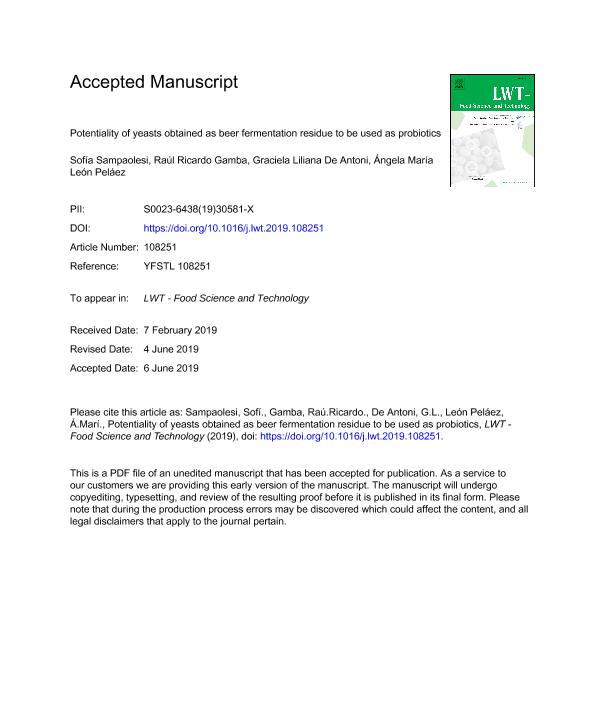Mostrar el registro sencillo del ítem
dc.contributor.author
Sampaolesi, Sofia

dc.contributor.author
Gamba, Raul Ricardo

dc.contributor.author
de Antoni, Graciela Liliana

dc.contributor.author
León Peláez, Angela Maria

dc.date.available
2021-04-28T18:24:41Z
dc.date.issued
2019-10
dc.identifier.citation
Sampaolesi, Sofia; Gamba, Raul Ricardo; de Antoni, Graciela Liliana; León Peláez, Angela Maria; Potentiality of yeasts obtained as beer fermentation residue to be used as probiotics; Elsevier Science; LWT - Food Science and Technology; 113; 10-2019; 1-7
dc.identifier.issn
0023-6438
dc.identifier.uri
http://hdl.handle.net/11336/130965
dc.description.abstract
Beer is the most consumed alcoholic beverage worldwide and brewery is a growing industry. Biomass by-product of beer production is constituted by viable and non-viable flocculated yeasts which are discarded. To increase the value of this waste, the potential applications of the beer fermentation residue (BFR) as probiotic and bio-preservative were studied. Strains isolated from commercial brewing starters and BFRs were identified. The M6 BFR and its constituent strains, Saccharomyces cerevisiae CMUNLPY6.2 and Pichia kudriavzevii CMUNLPY6.1, proved to be the most resistant to gastrointestinal conditions in vitro. The cell-free supernatants obtained from micro-fermentations were capable to reduce Aspergillus flavus and Aspergillus parasiticus germination, two species well-known to produce the potent carcinogenic aflatoxin B1 (AFB1). A cytoprotective effect of the BFRs against AFB1 on HepG2 cells was observed. Brewing yeasts bound AFB1 in vitro, thus reducing the cell damage induced by the toxin. Throughout the study, yeasts grown in brewing wort showed better probiotic properties than the same yeasts grown in YPD broth. These results suggest that the wastes obtained from brewery would become a high-value probiotic product.
dc.format
application/pdf
dc.language.iso
eng
dc.publisher
Elsevier Science

dc.rights
info:eu-repo/semantics/openAccess
dc.rights.uri
https://creativecommons.org/licenses/by-nc-nd/2.5/ar/
dc.subject
AFLATOXIN B1 BINDING
dc.subject
BEER FERMENTATION RESIDUE
dc.subject
BREWING YEAST
dc.subject
PROBIOTIC
dc.subject.classification
Biología Celular, Microbiología

dc.subject.classification
Ciencias Biológicas

dc.subject.classification
CIENCIAS NATURALES Y EXACTAS

dc.title
Potentiality of yeasts obtained as beer fermentation residue to be used as probiotics
dc.type
info:eu-repo/semantics/article
dc.type
info:ar-repo/semantics/artículo
dc.type
info:eu-repo/semantics/publishedVersion
dc.date.updated
2021-04-06T18:43:04Z
dc.journal.volume
113
dc.journal.pagination
1-7
dc.journal.pais
Países Bajos

dc.journal.ciudad
Amsterdam
dc.description.fil
Fil: Sampaolesi, Sofia. Consejo Nacional de Investigaciones Científicas y Técnicas. Centro Científico Tecnológico Conicet - La Plata; Argentina. Universidad Nacional de La Plata. Facultad de Ciencias Exactas. Departamento de Ciencias Biológicas. Cátedra de Microbiología General; Argentina
dc.description.fil
Fil: Gamba, Raul Ricardo. Consejo Nacional de Investigaciones Científicas y Técnicas. Centro Científico Tecnológico Conicet - La Plata. Centro de Investigación y Desarrollo en Fermentaciones Industriales. Universidad Nacional de La Plata. Facultad de Ciencias Exactas. Centro de Investigación y Desarrollo en Fermentaciones Industriales; Argentina. Universidad Nacional de La Plata. Facultad de Ciencias Exactas. Departamento de Ciencias Biológicas. Cátedra de Microbiología General; Argentina. Ishikawa Prefectural University; Japón
dc.description.fil
Fil: de Antoni, Graciela Liliana. Provincia de Buenos Aires. Gobernación. Comisión de Investigaciones Científicas; Argentina. Universidad Nacional de La Plata. Facultad de Ciencias Exactas. Departamento de Ciencias Biológicas. Cátedra de Microbiología General; Argentina
dc.description.fil
Fil: León Peláez, Angela Maria. Universidad Nacional de La Plata. Facultad de Ciencias Exactas. Departamento de Ciencias Biológicas. Cátedra de Microbiología General; Argentina
dc.journal.title
LWT - Food Science and Technology

dc.relation.alternativeid
info:eu-repo/semantics/altIdentifier/url/https://www.sciencedirect.com/science/article/abs/pii/S002364381930581X
dc.relation.alternativeid
info:eu-repo/semantics/altIdentifier/doi/https://doi.org/10.1016/j.lwt.2019.108251
Archivos asociados
